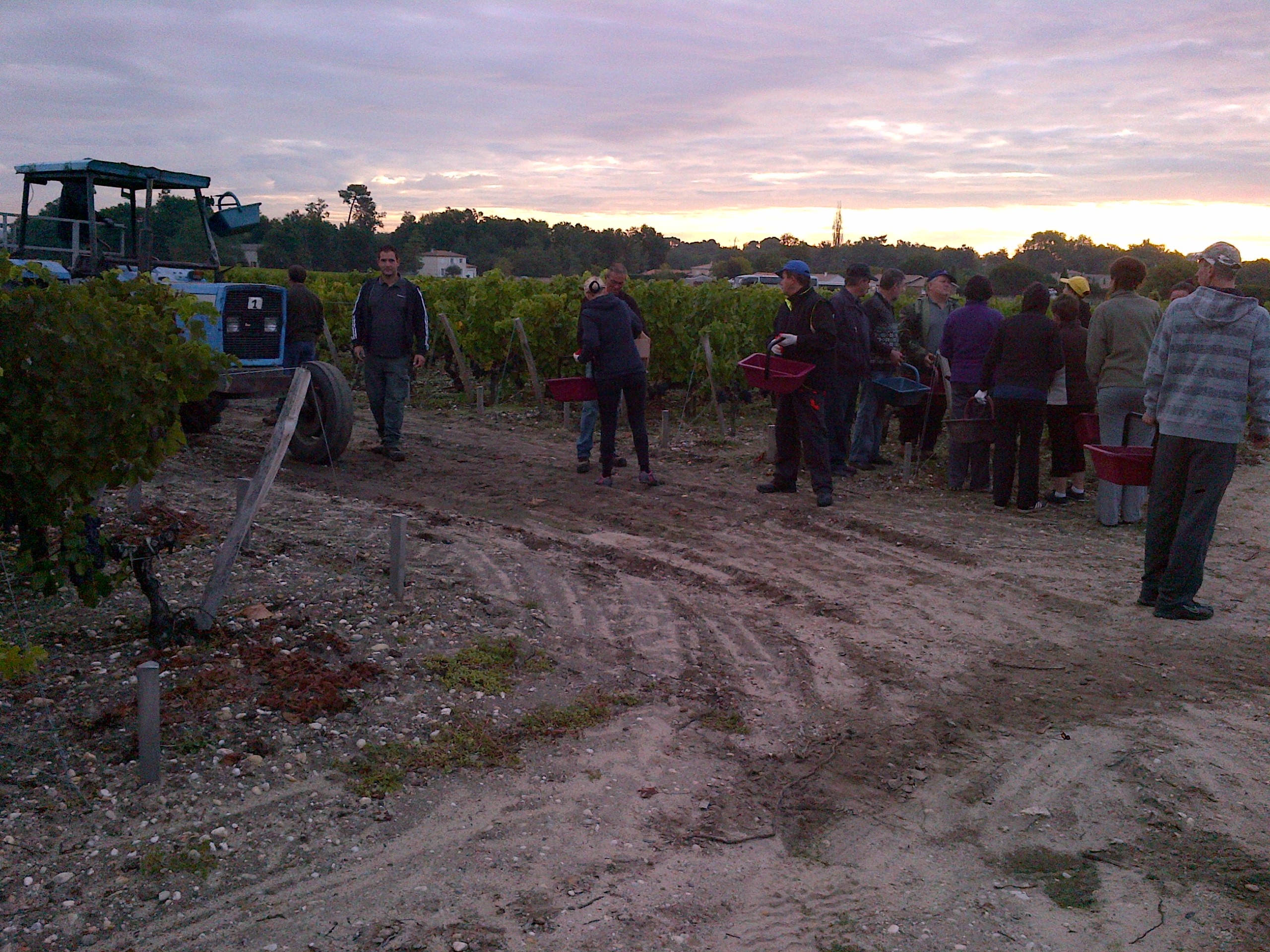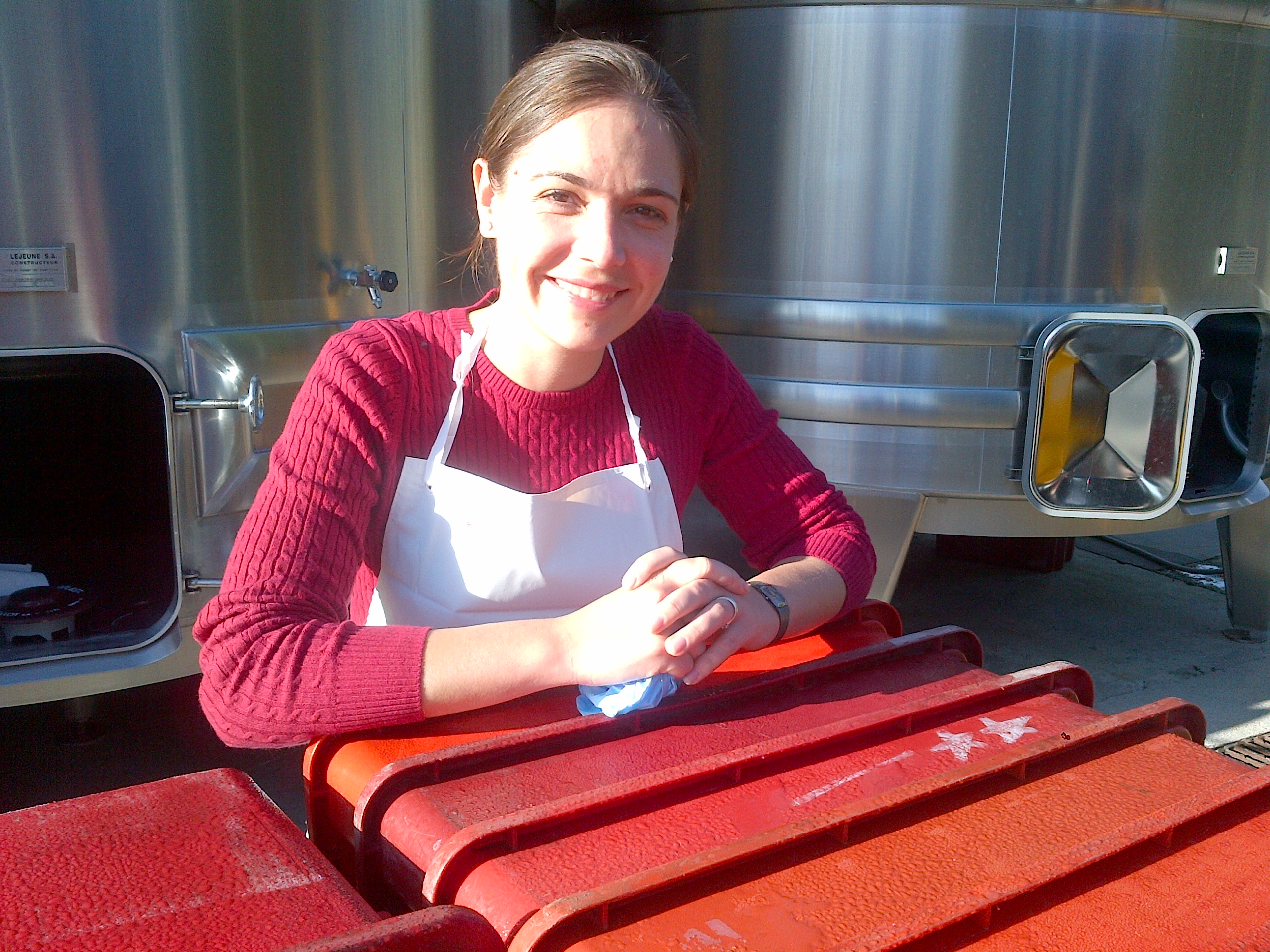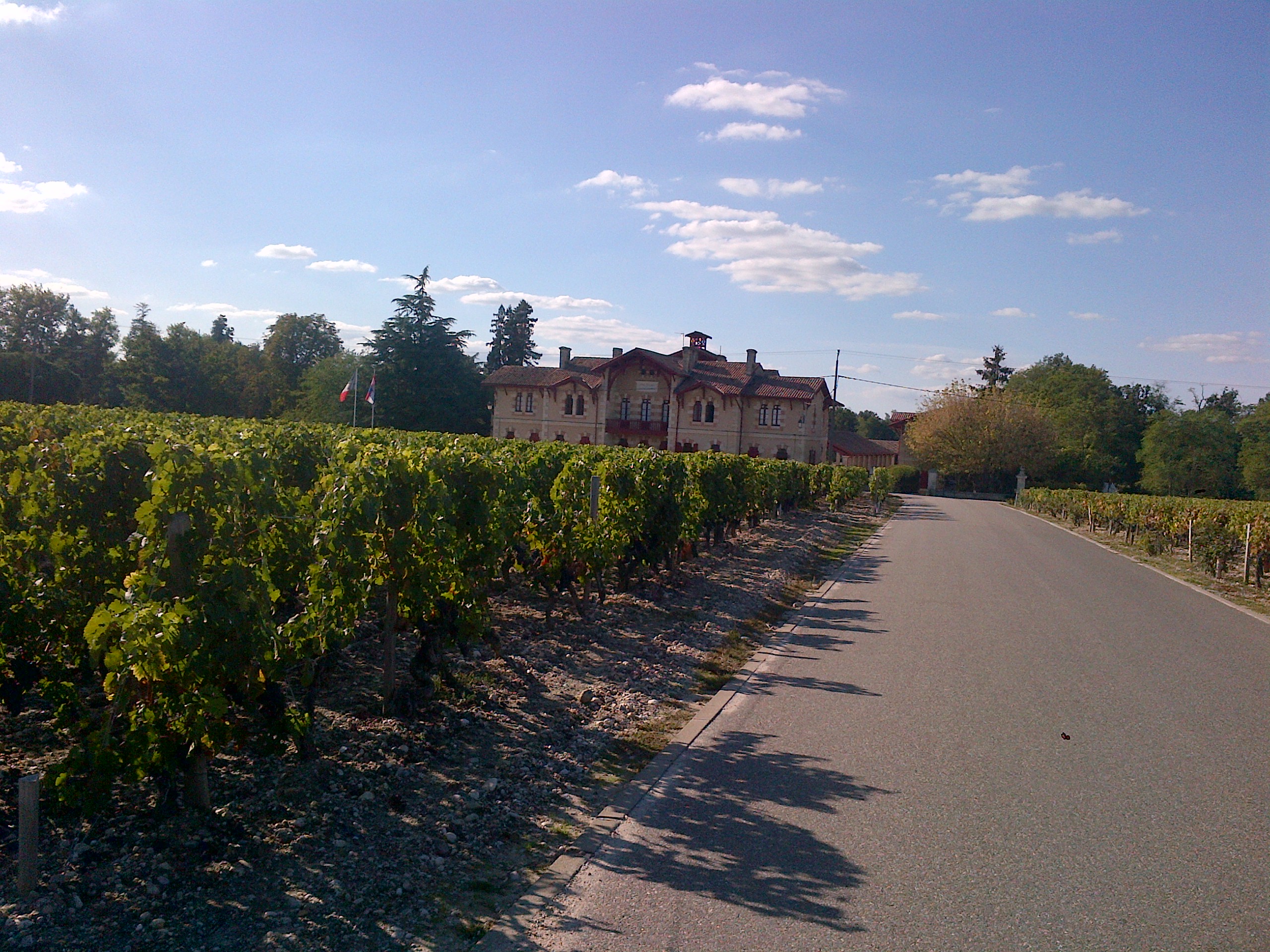Four days of harvesting at Ch. Giscours; the start of 2012!
Author: Berry Bros. & Rudd
 Stepping out of Bordeaux airport, I was greeted by a clear blue sky, heat and a gentle breeze. With a suitcase full of jumpers and a pair of wellies, I started to feel rather foolish and relieved. Foolish for not expecting the wonderful French autumn weather and forgetting my t-shirts at home and relieved that we won’t be harvesting in the rain and more importantly that this vintage may not be the drama the initial reports in the UK are predicting. I strongly believe that a vintage is made at harvest; good weather at harvest can make or break a vintage. The drying heat and the lovely breeze will dry the grapes and prevent rot and if the coming week can remain so beautiful the grapes won’t be swollen with water.
Stepping out of Bordeaux airport, I was greeted by a clear blue sky, heat and a gentle breeze. With a suitcase full of jumpers and a pair of wellies, I started to feel rather foolish and relieved. Foolish for not expecting the wonderful French autumn weather and forgetting my t-shirts at home and relieved that we won’t be harvesting in the rain and more importantly that this vintage may not be the drama the initial reports in the UK are predicting. I strongly believe that a vintage is made at harvest; good weather at harvest can make or break a vintage. The drying heat and the lovely breeze will dry the grapes and prevent rot and if the coming week can remain so beautiful the grapes won’t be swollen with water.
I have taken four days holiday to join the team at Ch. Giscours for the 2012 harvest. Situated in the heart of Margaux this beautiful Chateau is ranked alongside Ch. Palmer as a Third Growth in the 1855 classification. Having picked up my tiny white Citroen from Avis, it is short drive to Giscours.
Within minutes of passing Ch. La Lagune and Cantemerle, I could see the red, blue and white of the French and Dutch flags that greet visitors at the gate of Ch. Giscours (both the Chateau’s owner and general manager are Dutch). It is Sunday afternoon and everything is quiet and it takes me a while to find someone who can direct me to my lodgings. A charming gite becomes my home for the next four days and the window of my bedroom looks over the courtyard where the harvesters will share their daily lunch. I can’t resist the urge to walk through the vineyards to look at the fruit; the grapes look beautiful with clusters of dark purple berries with a thin layer of bloom. Ready for harvest!! A closer look, however, also shows many small green berries; the effect of a difficult spring, when much of the fruit did not set. At other places there are grapes that look more like small currants, withered from the intense heat and lack of water in early summer. Neither will affect the final wine, though will dramatically decrease the yield and increase the work at the sorting tables.
That evening I have dinner with a lovely couple with whom I share my lodgings. Patrick is Dutch and his delightful wife Aya is Japanese. Patrick exchanged a career in marketing to become a wine maker, and has worked in New Zealand, Australia, Canada, Japan and will now do a harvest at Giscours before hopefully one day establishing a vineyard of his own. They cook a terrific dinner and with a glass of wine, it soon feels home. Tomorrow……will hopefully bring the first grapes into the winery and the Chateau will start its busiest week of the annual calendar.
Blue skies and sunshine are our constant companion on Monday. I followed Patrick to the winery, where I met the winery team. The winery is located directly next to the Chateau and a minutes walk from our accommodation. Every morning each person that arrives shakes hands/gives a kiss to all those already present creating a friendly atmosphere. It somehow reminds me of a reception line at a wedding, except that this welcoming line grows with each person arriving and soon consists of twenty people! We spend the morning sorting grapes. The merlot is being harvested and arrives into the winery in small plastic crates to avoid the berries being crushed. Ch. Giscours is very lucky to have an optical sorting table. After the grapes have been destemmed they enter the optical sorting table, which not only removes all foreign bodies such as leaves and snails, but also takes an optical photograph of each berry and removes all unripe or raisened berries with a powerful jet. A fascinating machine that unfortunately comes at a high price (around 150,000 Euro), but is a necessity in a vintage such as 2012 giving Ch. Giscours a real quality advantage over properties that cannot afford such expenditure. In search of quality, Ch. Giscours still has a manual sorting table prior to the fruit entering the optical sorting table. Around ten people at all times remove leaves, botrytis (not much at all in 2012 -I saw maybe three bunches a day) and insects. Patrick mentioned that manual sorting in Australia meant removing rather large spiders…..a rather good reason never to volunteer there! The sweet smell of ripe grapes drifts over the sorting table and it is impossible not to taste the grapes while sorting them. Removing the snails (and creating a slimy zoo in front of Patrick) I feel the personal satisfaction of knowing that these have not ended up in the final wine. The berries and juice are automatically moved from the sorting table to the large stainless steel fermentation vats where they will spend around ten days for fermentation to complete prior to pressing. The grapes are left to macerate for a short period (about a day) before yeast is added to start fermentation.
 Lunch time is a social affair, when all the pickers, winery team and office staff meet for a simple three course meal with harvest wine. During the harvest, the team at the Chateau dramatically increases for a few weeks and everyone is looked after at lunchtime. It is a good way to improve my French as everyone discusses where they have come from. One comment I could not forget….someone suggested that I should spend a morning picking the grapes itself as ‘’one cannot understand the winery process without understanding the vineyard…..everything starts in the vineyard’’. After lunch I found my way to the office to ensure that they had a copy of my passport for insurance purposes and to spend a few hours catching up on some work (it is the only place with WiFi). The remainder of the afternoon is spent at the sorting table and I spend some time discovering the cellars. At the other entrance the grapes are brought in for Le Haut Médoc de Giscours, which are processed through a more simple destemmer and includes the fruit for the Rose de Giscours (always a favourite in our household). Around 6 o’clock we start the rigorous cleaning process that takes at least two hours.
Lunch time is a social affair, when all the pickers, winery team and office staff meet for a simple three course meal with harvest wine. During the harvest, the team at the Chateau dramatically increases for a few weeks and everyone is looked after at lunchtime. It is a good way to improve my French as everyone discusses where they have come from. One comment I could not forget….someone suggested that I should spend a morning picking the grapes itself as ‘’one cannot understand the winery process without understanding the vineyard…..everything starts in the vineyard’’. After lunch I found my way to the office to ensure that they had a copy of my passport for insurance purposes and to spend a few hours catching up on some work (it is the only place with WiFi). The remainder of the afternoon is spent at the sorting table and I spend some time discovering the cellars. At the other entrance the grapes are brought in for Le Haut Médoc de Giscours, which are processed through a more simple destemmer and includes the fruit for the Rose de Giscours (always a favourite in our household). Around 6 o’clock we start the rigorous cleaning process that takes at least two hours.
 Tuesday morning was spent in the vineyard. In the dark at 7:30am I reported to the vineyard manager to ask if I could join them in the fields for the morning. Eyeing me up from head to toe, he asked if I realized that I would ruin my shoes in a morning….quickly followed by a comment that I would probably ruin my jeans too. I confirmed that I really wouldn’t mind broken shoes and torn jeans and joined the pickers at the bus that would bring us to the first parcel of vines. At Giscours the vineyards are divided in parcels on the basis of soil analysis and these are picked and vinified separately. A large team of pickers allows for each parcel to be picked in a very short period, a tractor than transports the fruit to the winery and within hours fruit is in the fermentation vats. This diminishes the risk of bruised fruit or bacteria. It is in the vineyard that nations merge together and Polish, Spanish, Portugese, English and Dutch joined the local French in an attempt to bring the fruit to the winery as quickly as possible. It is hard work, but also very social as I heard the story of a young couple who are hitchhiking through Europe and had already harvested the Chardonnay and Pinot Noir in Burgundy before arriving in Bordeaux. With the relatively low training, harvesting in Bordeaux is back-breaking, but it was a very enjoyable morning. There is something immensely satisfying about harvesting beautiful looking purple bunches of grapes, knowing that it will be transformed into a glorious glass of wine. It is also an extra-ordinary sight to see the pickers swarm through a parcel at speed. My fingers were soon covered in sticky grape juice and the occasional cut from the secateurs and I definitely felt like I deserved my lunch. At least my shoes and jeans had survived the occasion….though both could do with a wash.
Tuesday morning was spent in the vineyard. In the dark at 7:30am I reported to the vineyard manager to ask if I could join them in the fields for the morning. Eyeing me up from head to toe, he asked if I realized that I would ruin my shoes in a morning….quickly followed by a comment that I would probably ruin my jeans too. I confirmed that I really wouldn’t mind broken shoes and torn jeans and joined the pickers at the bus that would bring us to the first parcel of vines. At Giscours the vineyards are divided in parcels on the basis of soil analysis and these are picked and vinified separately. A large team of pickers allows for each parcel to be picked in a very short period, a tractor than transports the fruit to the winery and within hours fruit is in the fermentation vats. This diminishes the risk of bruised fruit or bacteria. It is in the vineyard that nations merge together and Polish, Spanish, Portugese, English and Dutch joined the local French in an attempt to bring the fruit to the winery as quickly as possible. It is hard work, but also very social as I heard the story of a young couple who are hitchhiking through Europe and had already harvested the Chardonnay and Pinot Noir in Burgundy before arriving in Bordeaux. With the relatively low training, harvesting in Bordeaux is back-breaking, but it was a very enjoyable morning. There is something immensely satisfying about harvesting beautiful looking purple bunches of grapes, knowing that it will be transformed into a glorious glass of wine. It is also an extra-ordinary sight to see the pickers swarm through a parcel at speed. My fingers were soon covered in sticky grape juice and the occasional cut from the secateurs and I definitely felt like I deserved my lunch. At least my shoes and jeans had survived the occasion….though both could do with a wash.
The afternoon was spent in the winery setting up my first remontage. Remontage is a system where one draws the wine from the bottom of the vat and pump it to the top of the vat to spray it over the top, breaking up the crust of grapes that float to the top of the vat. It breaks the crust on top of the juice, preventing bacteria building up and releasing CO? (gives a horrible taste when it builds up and could stop fermentation). However, by letting the juice run into an open vat before pumping it back into the stainless steel vat, also allows extra oxygen to interact with the yeast activating the fermentation process further. When setting up a remontage the biggest risk is not to spill an entire vat of wine over the winery floor (somehow, I didn’t think they would like me coming back if I made that mistake). Patrick also told me the story of someone in New Zealand who had forgotten to remove the lid on top of the vat, creating a vacuum when he started to remove the wine and causing the entire stainless steel vat to buckle in upon itself like a crushed can…..oops! It also gave me the chance of tasting some newly made wine. Three day old fermenting juice is rich, sweet and tasted of wild strawberries, almost like a fruit smoothie with alcohol. Just as we started tidying up, I received an email with news that I had not expected to hear by email; my acceptance to the MW program. Without doubt some of the best news that I have heard in months and though I can now say goodbye to my social life, I am hugely excited to start these studies. I couldn’t stop grinning for most of the evening!
 Day three was completely focused on remontage. The vats at Giscours see three remontages a day and with an increasing number of vats filling up, this keeps a number of people occupied all day. I was soon left to set up my own remontage and had to joy of inoculating a vat with fresh yeast. There is something transfixing about watching a bucket of yeast come to life and adding it to the one day old grape must. It smells somewhere between a bakery and a brewery! One of the most exciting parts is seeing the difference between fresh grape juice, one day old fermenting juice and four day old juice…..the colour and extraction this year is really good and the dark clear purple hue that develops over a few days already makes me excited to taste the wine in March for the en primeur. I am so pleased to see this process happen and sad that I will not see the fully fermented juice leave the vats and finish its ageing in barrel. Neither will I see the Cabernet being harvested or the Petit Verdot…but at least I have had a flavour of the process, seen the enormous effort (and cost) involved in making this outstanding Margaux and made some new friends. Despite the modern machinery, I had an overwhelming feeling of stepping into an ancient tradition that continues a celebration of harvest and the creation of one of the world’s most famous beverages with a history of thousands of years. I am immensely grateful for the opportunity and would like to say a huge thank you to Alexander, general manager at Giscours, for giving me this opportunity and wish him and the team ‘good luck’ with the remainder of the harvest.
Day three was completely focused on remontage. The vats at Giscours see three remontages a day and with an increasing number of vats filling up, this keeps a number of people occupied all day. I was soon left to set up my own remontage and had to joy of inoculating a vat with fresh yeast. There is something transfixing about watching a bucket of yeast come to life and adding it to the one day old grape must. It smells somewhere between a bakery and a brewery! One of the most exciting parts is seeing the difference between fresh grape juice, one day old fermenting juice and four day old juice…..the colour and extraction this year is really good and the dark clear purple hue that develops over a few days already makes me excited to taste the wine in March for the en primeur. I am so pleased to see this process happen and sad that I will not see the fully fermented juice leave the vats and finish its ageing in barrel. Neither will I see the Cabernet being harvested or the Petit Verdot…but at least I have had a flavour of the process, seen the enormous effort (and cost) involved in making this outstanding Margaux and made some new friends. Despite the modern machinery, I had an overwhelming feeling of stepping into an ancient tradition that continues a celebration of harvest and the creation of one of the world’s most famous beverages with a history of thousands of years. I am immensely grateful for the opportunity and would like to say a huge thank you to Alexander, general manager at Giscours, for giving me this opportunity and wish him and the team ‘good luck’ with the remainder of the harvest.





Sara,
It’s really interesting to read your experience, giving me a flavour how good wine is produced.
Good luck on MW programme!